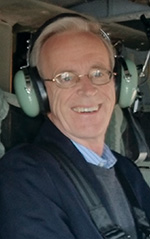Raqqa’s Inferno—A Diplomat Reads Dante in Syria
For this FSO, Dante’s imagery in The Inferno seemed to capture the depth of suffering and destruction he saw.
BY WILLIAM ROEBUCK
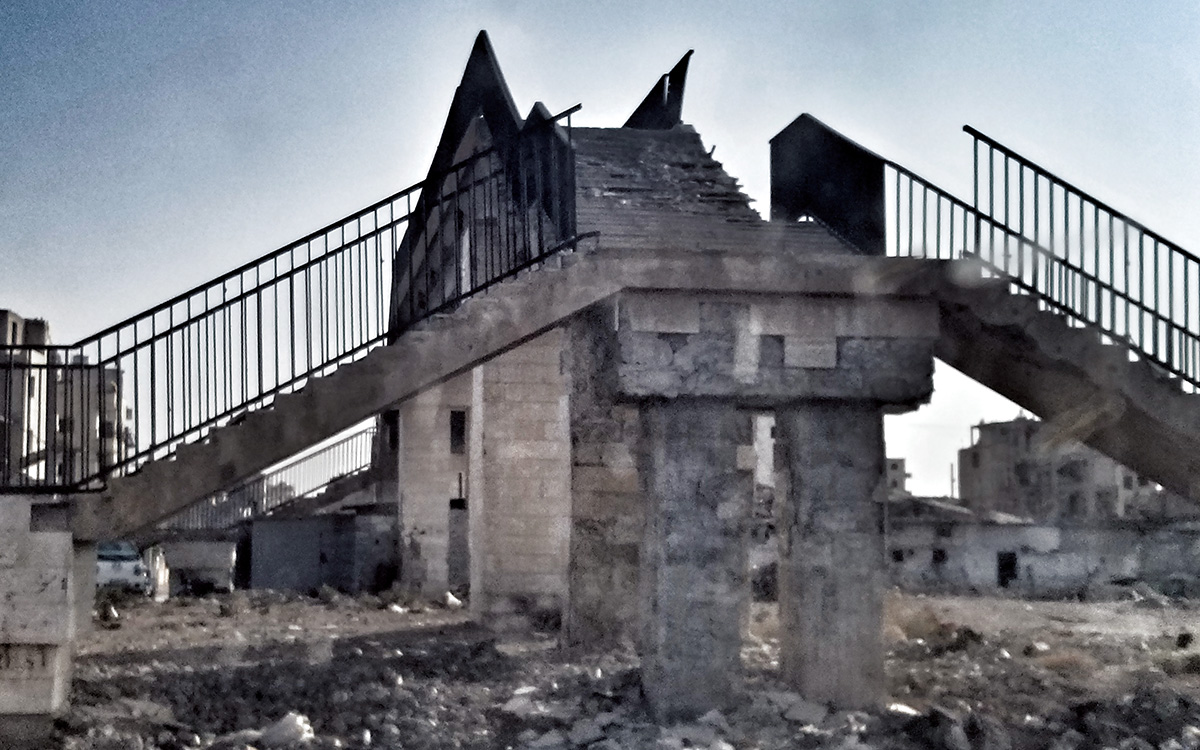
Driving through Raqqa in late February 2018 was to witness a “great wasteland” of destruction.
All Photos–William Roebuck
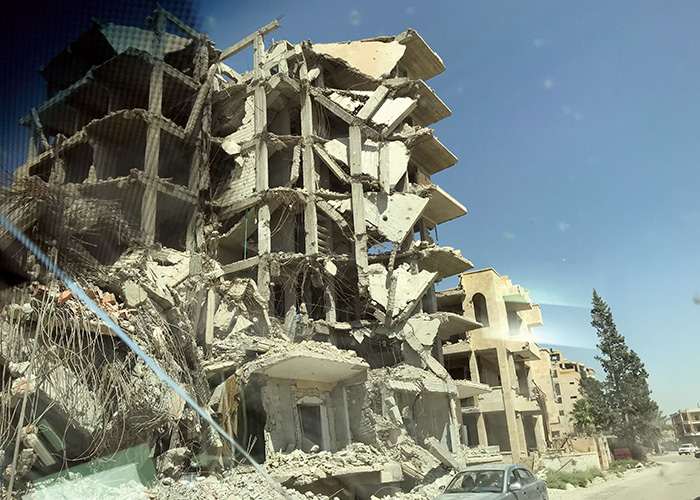
In June 2020, I wrapped up two and a half years of service as the senior U.S. diplomat on the ground in northeastern Syria. It was a terribly frustrating but also enriching experience. Frustrating, and saddening, because the Syrian conflict, with its bloodshed, destruction and human suffering, seemed immune to all our efforts to find a diplomatic solution.
Enriching because, among other reasons, I worked closely with the leadership of a talented local partner, the Syrian Democratic Forces, in the difficult but ultimately successful fight the U.S.-led coalition waged against ISIS. I was present in March 2019 at the Omar Oil Compound in Deir al-Zour when they declared the liberation of northeastern Syria from ISIS control. It was also my privilege to work closely in the field with U.S. Special Forces, with whom I was embedded, during my long sojourns in Syria beginning in early 2018.
Warned before my first deployment about the remote location and sketchy Wi-Fi, I understood that the experience represented an opportunity—in off-duty hours—to put some deep notches in the reading belt. I looked forward to knocking out a few books I had long eyed warily but slunk away from. Perhaps that explains how I ended up with Dante in my carry-on as I headed out on that first trip to Syria. I had begun The Inferno (Robert Pinsky’s relatively recent translation) before finishing my service as ambassador in Bahrain in late 2017, and hadn’t gotten far.
But when I rode into the largely destroyed city of Raqqa for the first time, in late February 2018, just a few months after the four-month military campaign had liberated it from ISIS, I had a jolt of recognition. I was seeing a vision of Dante’s hell before my eyes.
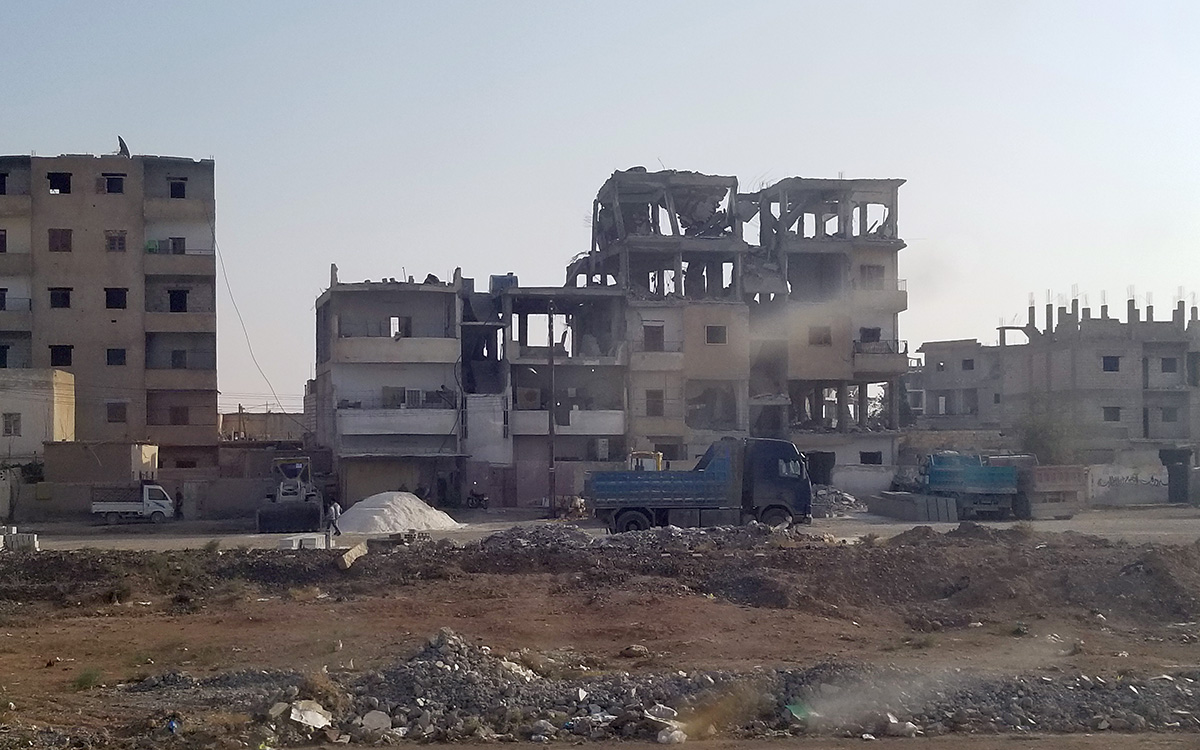
In Raqqa there were blocks and blocks where every single building had been hit, roofs knocked off, floors pancaked into crashing vectors of destruction.
A “Great Wasteland” of Destruction
In a line of armored jeeps accompanying a few visiting senior U.S. officials and escorted by both U.S. Special Forces and elements of our SDF counter-ISIS partners, we entered the city from the northwest. It was a cloudy, cold morning, with a bit of fog drifting through the streets. I had never seen anything like it—blocks and blocks where every single building had been hit. It reminded me of World War II photographs of the destruction of Dresden. Roofs were knocked off, some hanging like a lean-to down to the ground, against floors pancaked into crashing vectors of destruction. Slabs of concrete jutted out at wrong angles, like fractured limbs broken beyond what any cast would ever repair. More concrete hung from blasted ceilings, dangling in a mesh of wrinkled steel rebar like large insects caught in some horrific, oversized spider web.
Here and there, spray-painted, quasi-official graffiti notations were visible, in Arabic and sometimes English: “Clear,” meaning the building had been cleared of ISIS-planted mines or improvised explosive devices by one of the U.S.- or internationally funded nongovernmental organizations (NGOs) doing critically important, and dangerous, demining work. (At war’s end, Raqqa had the distinction of being one of the most heavily mined little corners of the globe.) At other points along the route, once-ominous ISIS graffiti were visible—Arabic voices from the grave, so to speak, still declaiming the wonders of the Islamic State or cryptically insisting “We remain.”
The destruction went on as far as one could see. (A subsequent helicopter ride over the city revealed that the blocks accumulated into square miles of devastation. Assessments by the Reconstruction Committee of the Raqqa Civil Council, the local post-liberation governing body for the city, estimated that 30,000 to 40,000 homes—65 percent of the total in the city—and an equivalent or greater number of nonresidential buildings had been leveled or damaged beyond repair.)
To my eye the destruction was fantastical, where old structures melted away or were staved in beyond recognition, frozen in contortions of havoc. A giant cell tower near the town square, struck by coalition bombing, was bent in half, like a monstrous praying mantis. Some scenes were reminders of the evil that ISIS had visited on the city: The front of the amphitheater, for example, was adorned with rows of unused mass graves ISIS had dug to intimidate residents with some “you next” iconography. There, and at Naim Traffic Circle (where ISIS declared Raqqa the capital of the caliphate in 2014), group executions had been common.
Even in the most desolate parts of the city, there were a few people around—some working to clear rubble in front of what seemed to have been their shops or dwellings, others trying to tear down the most thoroughly wrecked parts of structures they hoped to save. A man with a jackhammer, alone on the heavily damaged roof of a three-story building and clearly heedless of any personal safety issue, pounded away at outsized slabs of upended concrete.
Only 30 percent of the electrical grid in the city is currently operational, with the vast majority of residents still relying on generators.
With a mix of brutal realism and a clear lack of familiarity with how fiercely locals would remain attached to their little piece of Raqqa, no matter how destroyed, someone in my car suggested it would be easier to rope off the catastrophically destroyed city and build a new one nearby. I thought about the guy with the jackhammer, silhouetted in the early afternoon sun, pounding away in a gesture consisting of equal part futility and defiance, and understood that would never happen.
Near some of the most destroyed structures, scrappy Raqqawi entrepreneurs had gathered mangled steel rebar in large squiggly hairballs. They were using technology that seemed faintly medieval to straighten the rebar into long spaghetti strands they could resell. Others weren’t as industrious; they just sat outdoors on decrepit furniture they had apparently dragged out of their homes or buildings. They drank tea, smoked cigarettes and just hung out, stuck in some postapocalyptic scene that blended ordinary, urban Arab domesticity with horrific devastation.
Each seemed to be saying with his body language, “I’m back, remaking this place into my place, one broken piece of furniture or cracked brick at the time, if necessary.” Women in black abayas, partially or fully veiled, with hands often gloved in black as well, hurried past, with a child or two accompanying in varying degrees of compliance. The older, unaccompanied children we saw were invariably friendly, smiling and flashing V for victory signs. But the adults, mostly men, seemed sullen and reserved.
In less destroyed parts of the city, neighborhoods like Mishlab or Jezra on the outskirts, there were more signs of coming back to life: workers sweeping dirt and rubble out of their shops and garages, recently refurbished bakeries selling bread—a key staple in Syria—to long lines of people, kids zipping in and out of traffic on rickety bicycles, welding shops firing off sparks, and stands selling drinking water, while drinking-water delivery trucks circulated nearby, sloshing with contents recently pumped out of the Euphrates or more sketchy canals the river fed.
Eventually, as the returning population swelled past 150,000 during 2018, running water was restored to most of the city, and its recovery moved forward slowly, as schools, businesses and health clinics progressively reopened. The Department of State’s Syria Assistance Transition Response Team, known as START Forward, coordinated the U.S. government’s stabilization assistance program aimed at restoring essential services in northeastern Syrian locales like Raqqa, working closely with NGOs and local implementers.

Listen and Learn
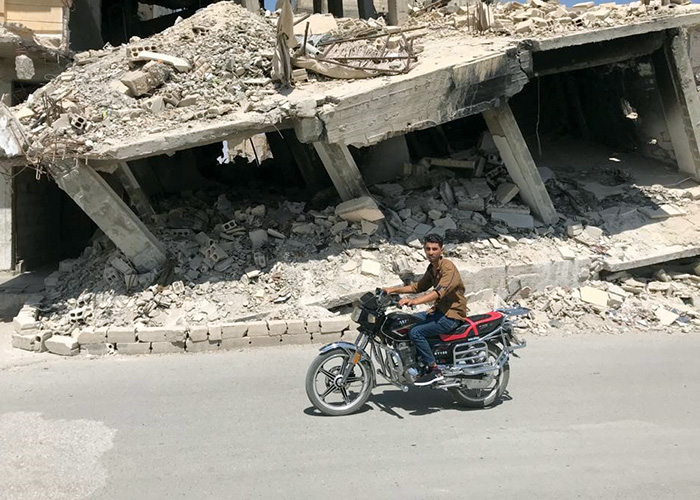
After that first ride through Raqqa, back in my CHU (containerized housing unit) at the makeshift U.S. military outpost on the ramshackle grounds of an abandoned cement factory a couple hours’ drive from Raqqa, I reflected on what I’d seen. I reviewed Canto XXV of The Inferno, which describes a series of horrible transformations that characters undergo: two heads merging into one, serpents growing feet, the hind paws of a creature merging to form the “member that man conceals.” Dante’s intense, bizarre, even grotesque imagery seemed to my mind to capture the depth of suffering and destruction in Syria.
The sense of sorrow was overwhelming. As Dante traversed the circles of his Inferno, he notes repeatedly that “pity overwhelmed” him. He speaks of being “half lost in its coils” and of being unable to speak because of the pity he felt, despite regular moments of stern judgment (consistent with the work’s context in 14th-century battles over papal authority). One could hear similar tones of judgment, though of very different origin, in Raqqa. Someone, often not originally from the city, would invariably insist, for example, that some Raqqa notable, or swaths of the community, had at one time pledged allegiance to ISIS, with the usually unspoken implication that the city’s suffering was, on some level, not completely undeserved.
Throughout his journey, Dante emphasizes the importance of listening to people, seeing their suffering and listening to their tales of woe, no matter how difficult it is to remain on that “deep and savage road” of sustained empathy. At one point his guide, Virgil, urges him to “speak directly” with the suffering soul they encounter and “hear from him about himself.” Each time I visited Raqqa over the next two years, I tried to listen carefully—to the complaints from locals about the slow pace of recovery, the perceived small scale of assistance in comparison with the huge scale of destruction, and to residents’ usually surreptitious complaints about what they viewed as heavy-handed, intrusive Kurdish political influence and security presence in the overwhelmingly Arab city—influence that had come in during the fight against ISIS and stayed.
Sometimes I did not understand precisely what people were trying to tell me. One afternoon in front of a severely damaged school building, a man asked defiantly why I was there, indicating that the visit of a U.S. diplomat was not helpful. “Who did this?” he said, pointing to the destruction all around. “Who will fix it?” He mentioned the importance of respect; the citizens of Raqqa were experiencing its opposite, he opined, given what he viewed as a stingy international response in the face of so much destruction.
He spoke warily, eyeing the Kurdish security escorts accompanying our group whom he viewed as outsiders bent on preventing critical views from being heard. I struggled with my rusty Arabic to pry out more meaning from his enigmatic and disjointed, but piercing observations. Recalling the conversation later, I thought of Dante, who describes becoming “like those who, feeling laughed at, hesitate / Not comprehending what’s been said to them / And helpless to reply.”
Just as Dante leaned on Virgil, I relied on trusted guides to lead me through Raqqa’s inferno. They included a small number of talented Foreign Service officers and members of that START Forward team, as well as the U.S. military’s civil affairs teams, who also focused on restoring basic services such as repairing water pumping stations and small bridges, and cleaning out irrigation canals. My guides in the city also included dedicated local officials and first responders, often affiliated with the Raqqa Civil Council or the municipality. They described in detail—and took me on inspection tours of the city to show me—the overwhelming levels of destruction and make clear the massive assistance needed to rebuild the shattered city.
I talked to many others, as well, like the local attorney who knew the ancient history of Raqqa and guided me over its long-forgotten (and abbreviated) heyday as a capital of the storied ninth-century Abbasid Caliphate and the city’s lineage centuries later as an Ottoman-era customs post. His historical references to Islam reminded me of Dante’s recognition of the great contributions of Muslim philosophers like Avicenna and Averroes, and brought to mind scholarly commentary making the case that the Prophet Mohammed’s night journey from Mecca to Jerusalem represented possible source material for Dante’s great allegory.
One of my most faithful and talented guides did not himself escape the inferno. Raqqa Civil Council adviser Omar Alloush led me through the political maze that constituted Arab-Kurdish relations and shared the backstories behind the effort to help Raqqa recover and rebuild. A Kurd who played a critical role in the effort to stand up local governance and improve the sometimes thorny relations between Arab and Kurdish communities in northeastern Syria, he was killed in his nearby hometown of Tel Abayad in October 2018 by unknown assailants.
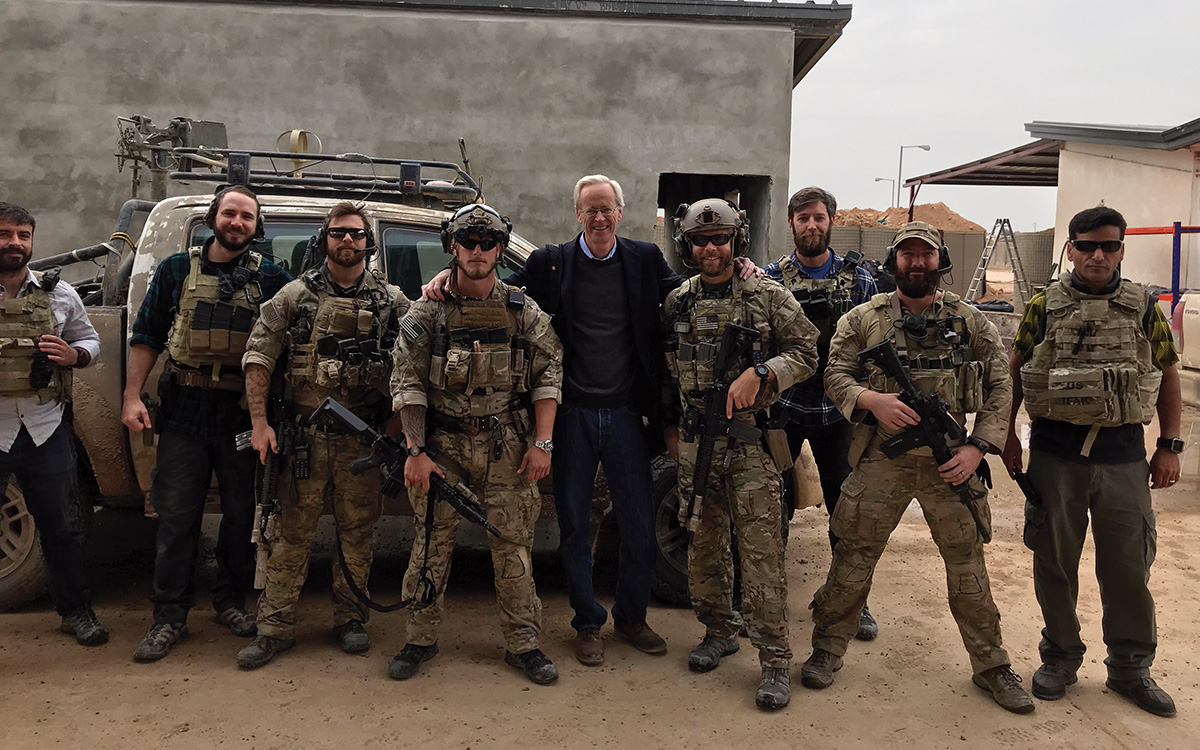
The author with U.S. military, on a visit in the Deir al-Zour area in 2019.
Hope and Fear
Since late 2017 when ISIS was driven out of the city, Raqqa has struggled with limited international assistance flows. This is the result, in part, of the obstructionist Syrian regime, whose toxic presence in Damascus dried up prospects for larger-scale reconstruction assistance (for which stabilization assistance typically prepares the way) and, frankly, by inadequate funding for stabilization assistance from donor countries, including from the United States.
After President Donald Trump, irritated that coalition partners were not contributing more to this effort, froze $200 million in U.S. government stabilization assistance in 2018, partners stepped up with funding to support the U.S. programs; but by mid-2019, that burden-sharing effort lost steam. And as of the fall of 2020, most stabilization programming for Raqqa, like the rest of northeast Syria, faced a cascading series of shutdowns as funding streams dried up. (Funding for humanitarian assistance, focused on the desperately poor and vulnerable in refugee and displaced persons’ camps, meanwhile, has been more robust, with the U.S. leading the way.)
As of this writing, a third of 40-some schools in the city have been refurbished to rudimentary levels and are operational. Most of the hospitals in the city are operational at varying levels. But only 30 percent of the electrical grid in the city is currently operational, with the vast majority of residents still relying on generators. And while close to 80 percent of Raqqa province relies on agriculture, the pumping stations, irrigation canals, grain silos and the rest of the farming infrastructure remain severely damaged.
On visits to the city in 2018 and 2019, I noted particularly the remains of the two bridges across the once-majestic Euphrates, now shrunk by persistent drought and upriver Turkish damming projects completed over past decades. Coalition forces bent on cutting off ISIS forces in the city from reinforcements or escape routes had systematically targeted them with airstrikes. Destruction of the bridges cut Raqqa off from its northern and western provincial hinterlands, the agricultural engine on which the city’s economy depends.
It wasn’t only the contradictions and ambiguities that made capturing Raqqa’s story challenging. As in Dante’s Inferno, there was an obscure palette of history and politics in the background.
Like characters in Dante’s Inferno, who board ferries across the river Styx, residents of Raqqa have had to make their way across the river amid a disorderly fleet of dhows, fishing boats and other barely river-worthy craft, spewing diesel fumes and ferrying residents and visitors into and out of the city. The wrecked bridges are also emblematic of the isolation that Raqqa citizens articulated, a feeling of being cut off from an international community that willfully ignored the city’s destruction and need for greater help with rebuilding.
Mixed in with concerns about isolation, Raqqa’s predominantly Arab citizens also articulated a range of fears about their future. Despite the complaints about Kurdish influence and a heavy-handed SDF security presence, they expressed fear that Kurdish-dominated SDF would abandon them prematurely, because the Kurds sought a “separate peace” with the Syrian regime to lock in autonomy for the Kurdish heartland farther east. (This has not happened; SDF commander General Mazloum Abdi, a Kurd, has made clear his intention to continue providing security to these Arab areas.)
While sometimes blaming the U.S. for destroying their city and refusing to help rebuild it, most I spoke with nonetheless expressed satisfaction with the continuing U.S. military presence in the northeast and voiced fears about the U.S. not staying the course. The Syrian regime’s propaganda remained aggressive. Some residents, confronting what they viewed as the unavoidable prospect of an eventual American withdrawal from the region, contemplated the painful choice—as they articulated it—between a future dominated by the Syrian regime or Turkey.
Like Dante’s interlocutors, who urged him to bear witness to their suffering, many I spoke with asked that their fears—and resentments—be communicated to Washington. Those fears were exacerbated in October 2019 when, in the wake of Turkey’s Operation Peace Spring military action, U.S. military forces withdrew from Raqqa and the rest of the western half of northeastern Syria. To date, the SDF has maintained its presence in these areas and pushed back against Russian and Syrian regime efforts to assert control of the areas from which the U.S. withdrew.
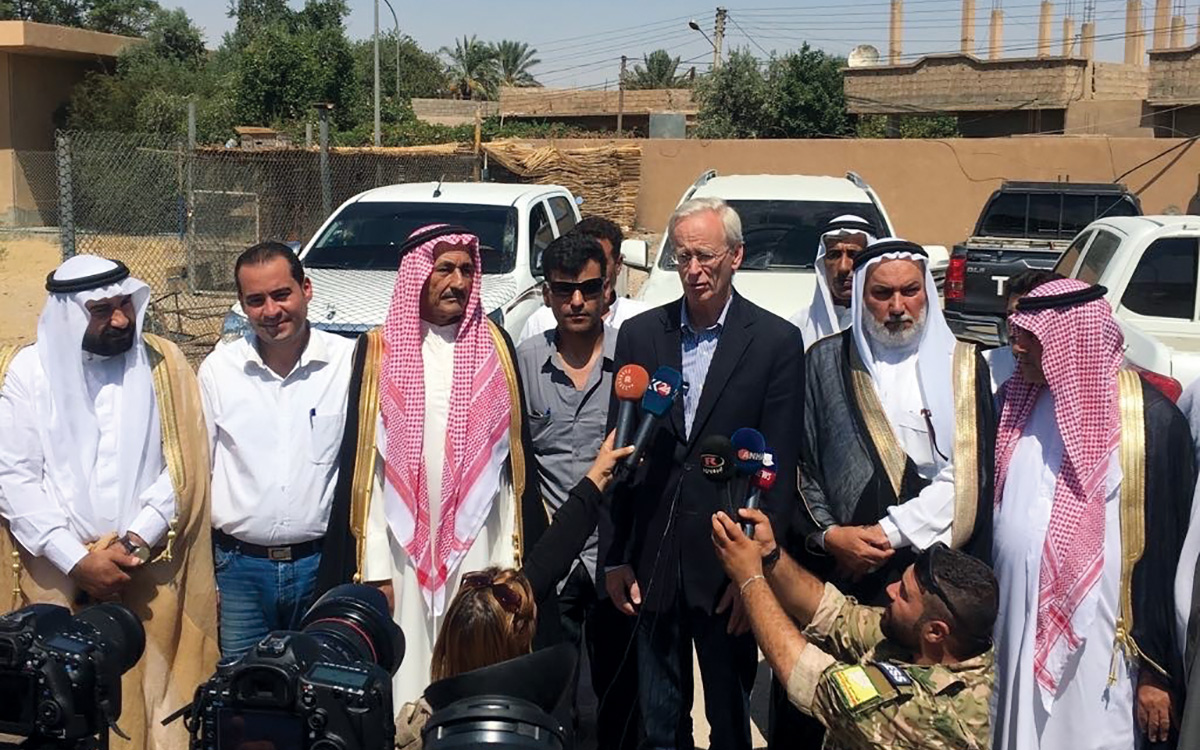
William Roebuck, at center with microphones, and tribal sheikhs in Busayrah, Deir al-Zour province, in August 2018, during a visit to hear local views and ensure continued cooperation in the fight against ISIS in northeastern Syria.
Finding the Words

Students in class at a refurbished school in Raqqa in 2018.
As I struggled to articulate for Washington the cluster of fears, resentments and contradictions and half-contradictions I had heard about the future of Raqqa, I thought of Dante’s concern that he would not “find words … [or the] harsh and grating rhymes to befit that melancholy” place. In his 14th-century poetic vernacular, Dante underscored the need for objective, fact-based reporting: “May the muses help my verse … so that word not diverge from fact, as it takes its course.” He and Virgil emphasized the importance of experience, of seeing the world as it is, not distorted by preconceptions. Dante also understood the power of narrative; he urged the people he met, in their “punished state,” to speak to him—“So that your memory in men’s minds … won’t fade.”
It wasn’t only the contradictions and ambiguities that made capturing Raqqa’s story challenging. As in The Inferno, there was an obscure palette of history and politics in the background. The Syrian backdrop is no less complex—whether it is the fractious, hard-to-follow histories of this or that militant group opposing the Assad regime but also expending tremendous energy killing its jihadi rivals, when not collaborating with them, as they all fought for influence after the defeat of ISIS’s physical caliphate; or whether it’s the sometimes equally hard-to-follow diplomatic clashes—in Damascus, Geneva, Washington or Astana—as we, the United Nations, Russia, Turkey and others struggled over how to end the civil war and start the real conversation on the future of Syria.
Always my thoughts returned to that tough, determined citizen of Raqqa, up three stories on his fractured roof, blasting away with his jackhammer at debris that only high explosives and a wrecking ball could adequately address. He would do whatever he could to reclaim his home. I also thought of Dante’s 14th-century world, long gone except in a literary universe that we access with a combination of patience, suspension of disbelief, and appreciation for language and story—not unlike the effort a diplomat must make to report with empathy and honesty the devastation he sees and the suffering and concerns he hears about.
The Inferno concludes on an encouraging note of sorts, with Dante and Virgil making a nocturnal climb from the underworld “back up to the shining world … Where we came forth, and once more saw the stars.” It reminded me of a nighttime visit I made to Raqqa to gauge atmospherics in the troubled city. Warned ahead of time that Raqqa at night, with its desolate, destroyed neighborhoods and lack of security, took on a more ominous, frightening note, I was surprised to discover a bustle of commercial and social activity in significant parts of the city: young men in a rustic internet café, families sitting on carpets and chatting outside their homes, amid patches of rubble, and a rickety Ferris wheel keeping kids amused in a recently refurbished park.
By the sheer determination of its local inhabitants, Raqqa will continue to recover. But the road ahead, to cite Dante one final time, is likely to be “tangled and rough” at best, given the ongoing conflict in Syria, the meager levels of international assistance and the absence of a single, galvanizing international consensus regarding that nation’s future.
Read More...
- “A US Ambassador Ends His Service on the Front Lines in Syria: Reflections on U.S. foreign policy in a wartorn state,” by William Roebuck, Defense One, March 31, 2021
- “U.S. Envoy in Syria Says Not Enough Was Done to Avert Turkish Attack,” by Eric Schmitt, The New York Times, November 7, 2019
- “Hard Truths in Syria America Can’t Do More With Less, and It Shouldn’t Try,” by Brett McGurk, Foreign Affairs, May/June 2019

